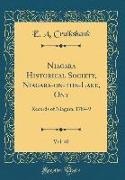Read more
Excerpt from Niagara Historical Society, Niagara-on-the-Lake, Ont, Vol. 40: Records of Niagara, 1784-9
The following letters written by John Dease, while he was acting as deputy superintendent of Indian affairs at Niagara in the absence of Colonel Butler did not come to the attention of the editor in time to be included in their proper chronological order in the last publication of this society. They are considered of sufficient historical value to warrant their publication now. Dease was a kinsman of Sir John Johnson, whom, it will be ob served, he addresses as his cousin, and probably owed his appoint ment to his in¿uence. When Butler returned, Dease was appointed commissary of Indian affairs at Michilimackinac. In July, 1787, a council of the chiefs of the nations of Indians in the far west was held there, at which he appeared as Sir John John son's representative and presented to them a written treaty of peace with each other which they were induced to accept and ratify. But his term of office at that post was short for a number of the leading traders soon after signed a memorial, in which they alleged that the goods destined as presents to the Indians have been privately traded against our interests, and that the store established for the protection of Commerce has become itself a trading post entirely opposed to our interest. This complaint was deemed so serious that a court of inquiry was held and evidence taken at great length. This evidence and the defence made by Dease and Ainse, his chief interpreter, were referred to the attorney-general and solicitor-general for the Province of Quebec, who reported that Mr. Dease being the superior is the more immediately accountable and responsible, but Mr. Ainse has shown nothing to excuse himself, nor have either discharged themselves in our opinion of the very heavy charges which lay against them.
Dease was permitted to retire on a pension of one hundred pounds per annum.
About the Publisher
Forgotten Books publishes hundreds of thousands of rare and classic books. Find more at www.forgottenbooks.com
This book is a reproduction of an important historical work. Forgotten Books uses state-of-the-art technology to digitally reconstruct the work, preserving the original format whilst repairing imperfections present in the aged copy. In rare cases, an imperfection in the original, such as a blemish or missing page, may be replicated in our edition. We do, however, repair the vast majority of imperfections successfully; any imperfections that remain are intentionally left to preserve the state of such historical works.

